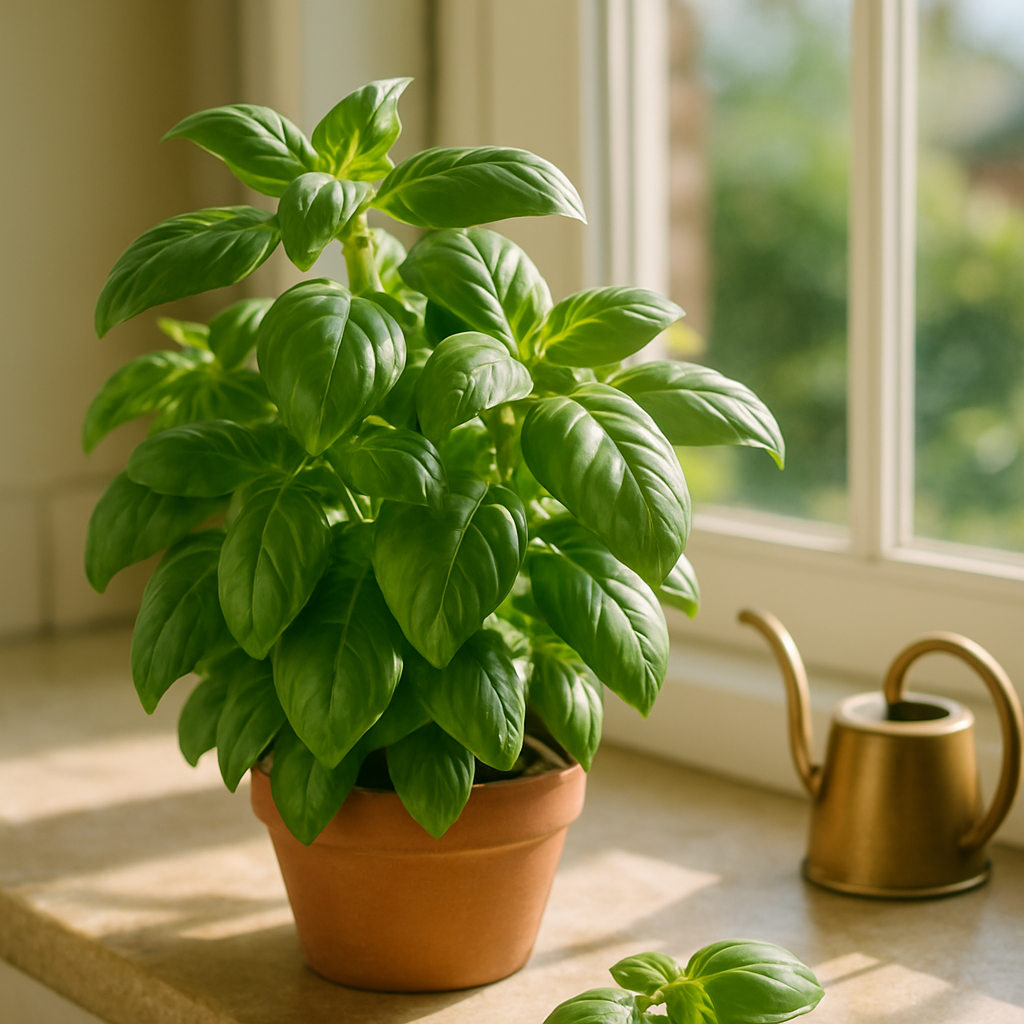Introduction
Learning how often to water basil is a common question for every gardener, whether you’re growing a few pots on your kitchen windowsill or tending rows of fresh basil outdoors. Basil is a favorite herb for both cooks and gardeners—renowned for its fragrant leaves that elevate everything from pasta to salads. But neglecting basil’s watering needs can quickly turn lush, productive plants into droopy stems with bitter-tasting leaves. Water too much, and you risk root rot; water too little, and the leaves wilt or stop growing.
In this article, you’ll discover expert-backed guidelines on how often to water basil, including real examples for indoor and outdoor plants, the role of climate and soil type, and clear warning signs that your basil needs a change in routine. Whether you’re a beginner or a basil veteran, you’ll walk away with actionable tips to achieve maximum yield all season long.
How Much Water Basil Needs
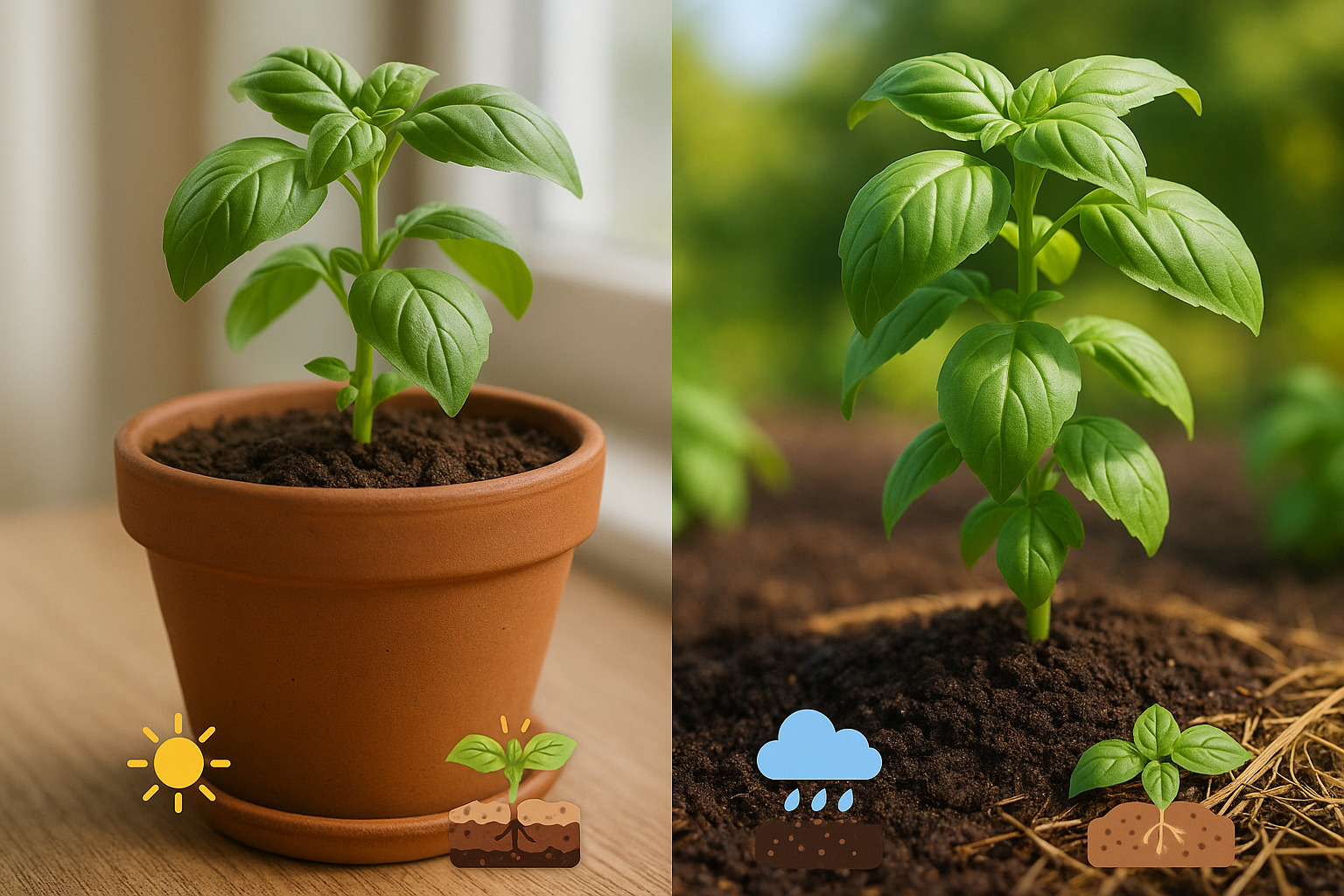
Basil thrives when its soil is kept consistently moist, but not waterlogged, so it’s crucial to find the right balance—especially when growing it in pots or garden beds.
In pots, basil typically needs to be watered every 1-2 days during hot weather, since containers dry out faster than the ground. For garden beds, watering once or twice a week is usually enough, though this can vary based on rain and temperature.
Your soil type plays a big role: sandy soils dry out quickly and may demand more frequent watering, while clay-rich or organic soils retain moisture longer. Sunlight is also a factor—basil grows best in full sun, but hotter, sunnier spots mean you’ll need to water more often to prevent wilting.
Meanwhile, high humidity slows evaporation, so your basil might need less frequent watering on muggy days. The goal is always to keep the soil evenly damp—stick your finger about an inch deep; if it feels dry, it’s time to water.
Avoid letting the soil dry out completely, but don’t let it get soggy either, as overwatering can suffocate roots and promote diseases like root rot. Mulching around your basil can help lock in moisture and keep the soil temperature steady.
For healthiest growth, remember that basil’s ideal is Goldilocks’ style—not too wet, not too dry, but just right. Observing your basil regularly for drooping leaves or yellowing can help you fine-tune your watering routine for happy, aromatic plants.
How Often to Water Basil (Indoors & Outdoors)
Basil is a thirsty herb, but its watering needs vary depending on where and how it’s grown. For indoor basil, aim to water every 3–4 days, checking that the top inch of soil feels dry before watering again. A consistent schedule is crucial since indoor air can dry pots out faster than you might expect.
Outdoor potted basil usually requires more frequent attention, especially in hot or windy weather. Daily watering may be necessary in midsummer, while every other day might suffice in spring or cooler climates.
Basil planted directly in garden beds generally needs less frequent watering, about twice a week, but this depends on your soil. It should stay evenly moist but never soggy. Always check the soil about an inch deep; if it feels cool and just barely moist, your basil is happy.
Remember, seasonal changes matter: basil in summer heat loses moisture quickly, demanding vigilant watering, while cooler months or rainy periods call for less frequent watering. Scale back then to prevent root rot. Mulching your outdoor basil can help conserve moisture and reduce watering needs.
Above all, watch your plant’s leaves—drooping or yellowing can signal over- or under-watering. Adjust your routine as needed. By tailoring your care to your basil’s specific environment, you’ll keep it lush and productive all season long.
When Is the Best Time to Water Basil?
The best time to water basil is early in the morning, ideally before the sun gets too strong. Watering at this time allows the plant’s leaves and soil surface to dry out during the day, which helps prevent fungal diseases like powdery mildew and root rot—both of which thrive in consistently damp conditions.
Morning watering also ensures the basil has enough moisture for strong growth throughout the hottest part of the day. In contrast, watering in the evening can leave leaves and soil wet overnight, increasing the risk of disease.
To determine if your basil truly needs water, check the soil by sticking your finger about an inch deep near the plant; if it feels dry, it’s time to water. Be sure to water the base of the plant rather than overhead to keep the foliage dry and healthy.
Another tip: basil grown in pots dries out faster than those in garden beds, so these may need more frequent checks. By sticking to a morning schedule and keeping a close eye on soil moisture, you’ll help your basil thrive—strong, green, and flavorful—all season long.
Recognizing Overwatered and Underwatered Basil
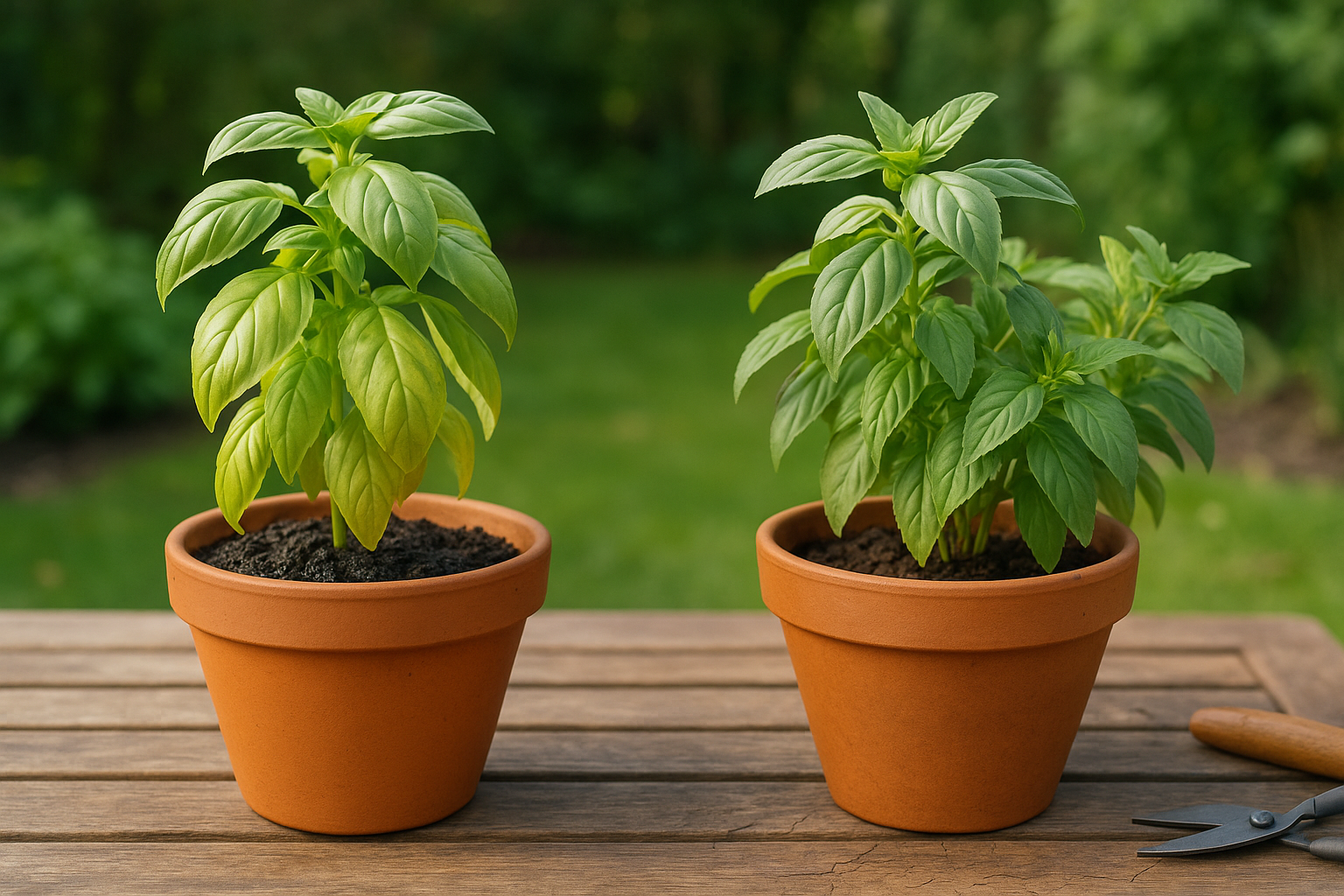
Knowing how to tell if your basil is getting too much or too little water can make all the difference in keeping it healthy. Overwatered basil often reveals itself with yellowing leaves, especially on the lower part of the plant. You might also notice the soil stays soggy or a musty smell near the roots—signs that root rot could be setting in. The plant may droop even though the soil is wet, which can be confusing.
In contrast, underwatered basil usually has dry, brittle leaves that curl or brown at the edges, and the whole plant can look wilted or lifeless. Growth slows down and leaves might drop off entirely.
The good news: both issues are fixable!
How to Fix Overwatered Basil
- Let the soil dry out—poke your finger in and wait to water until the top inch feels dry.
- If you spot root rot, trim away mushy roots and repot in fresh, well-draining soil.
How to Fix Underwatered Basil
- Water deeply so moisture reaches the roots.
- Don’t let the soil dry out completely between waterings.
A helpful tip is to water basil when the top inch of soil is dry but before the leaves start to wilt. Also, make sure your pot has drainage holes to prevent future problems.
Adjusting your routine and observing your plant regularly will help you catch issues early and keep your basil thriving, whether it’s on your kitchen windowsill or in the garden.
How Climate and Environment Affect Basil Watering
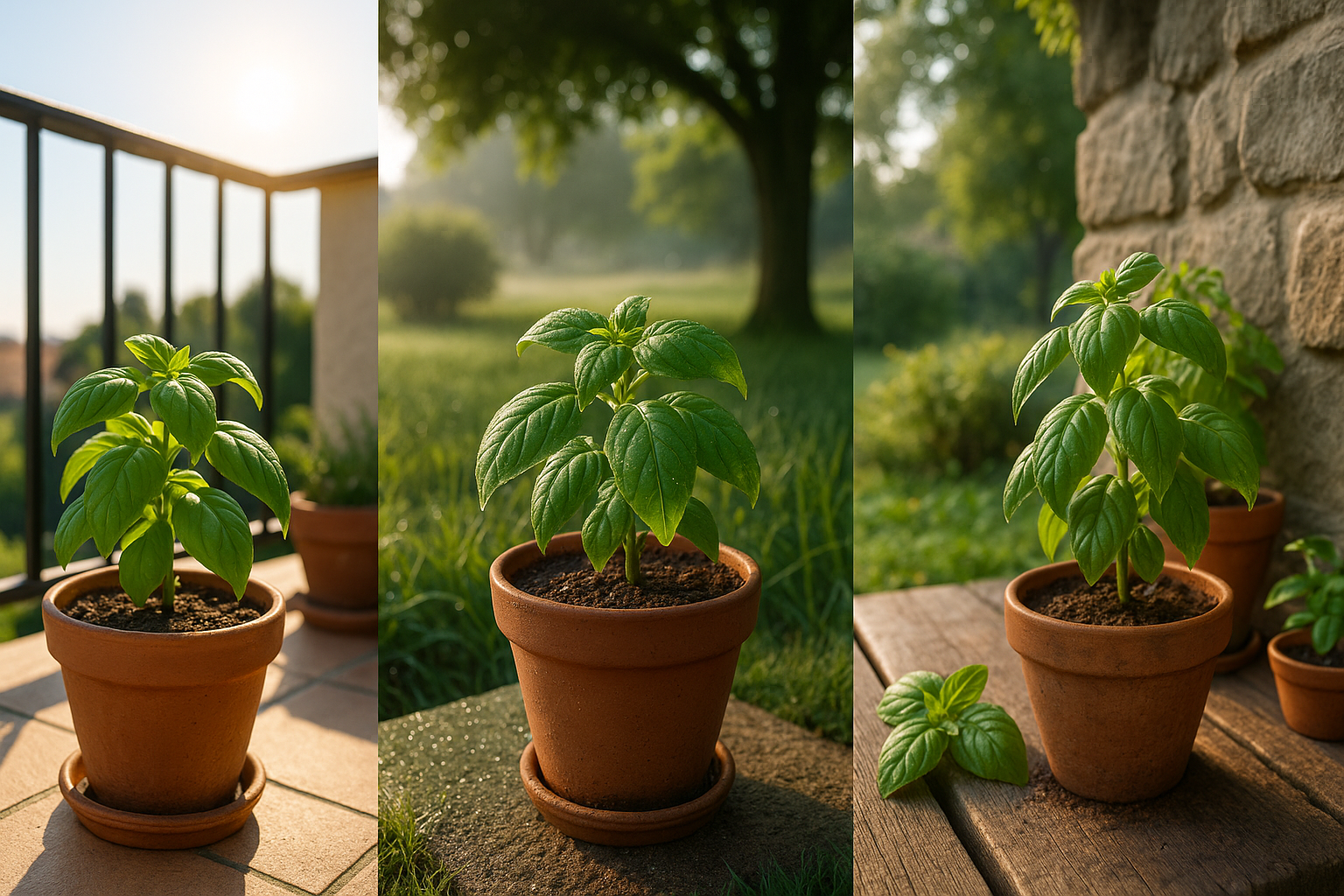
Temperature, humidity, and sunlight all play a big role in how much water your basil needs. In hot and dry climates, basil’s soil dries out quickly, so you may need to water daily or every other day—always check the top inch of soil for dryness before watering.
When temperatures soar above 85°F (29°C), basil can go limp fast, so it’s smart to water in the early morning to help the plants beat the heat. In cool or humid climates, however, basil holds onto moisture longer. Overwatering is a real risk here, so let the soil dry out a bit more between waterings, and always make sure pots have good drainage.
If you notice yellowing leaves or soggy stems, cut back on water. With changing weather, keep an eye on forecasts: after rain or cloudy days, wait until the soil feels just dry to the touch before adding more water.
Microclimates—like balconies, garden beds near stone walls, or spots shaded by trees—can also affect how fast basil dries out. One handy tip is to group basil with other herbs or plants that have similar watering needs, so you can easily manage their care as conditions change.
Ultimately, paying close attention to your plant and adjusting as needed is the best way to keep basil thriving.
Watering Tips for Maximum Basil Yield
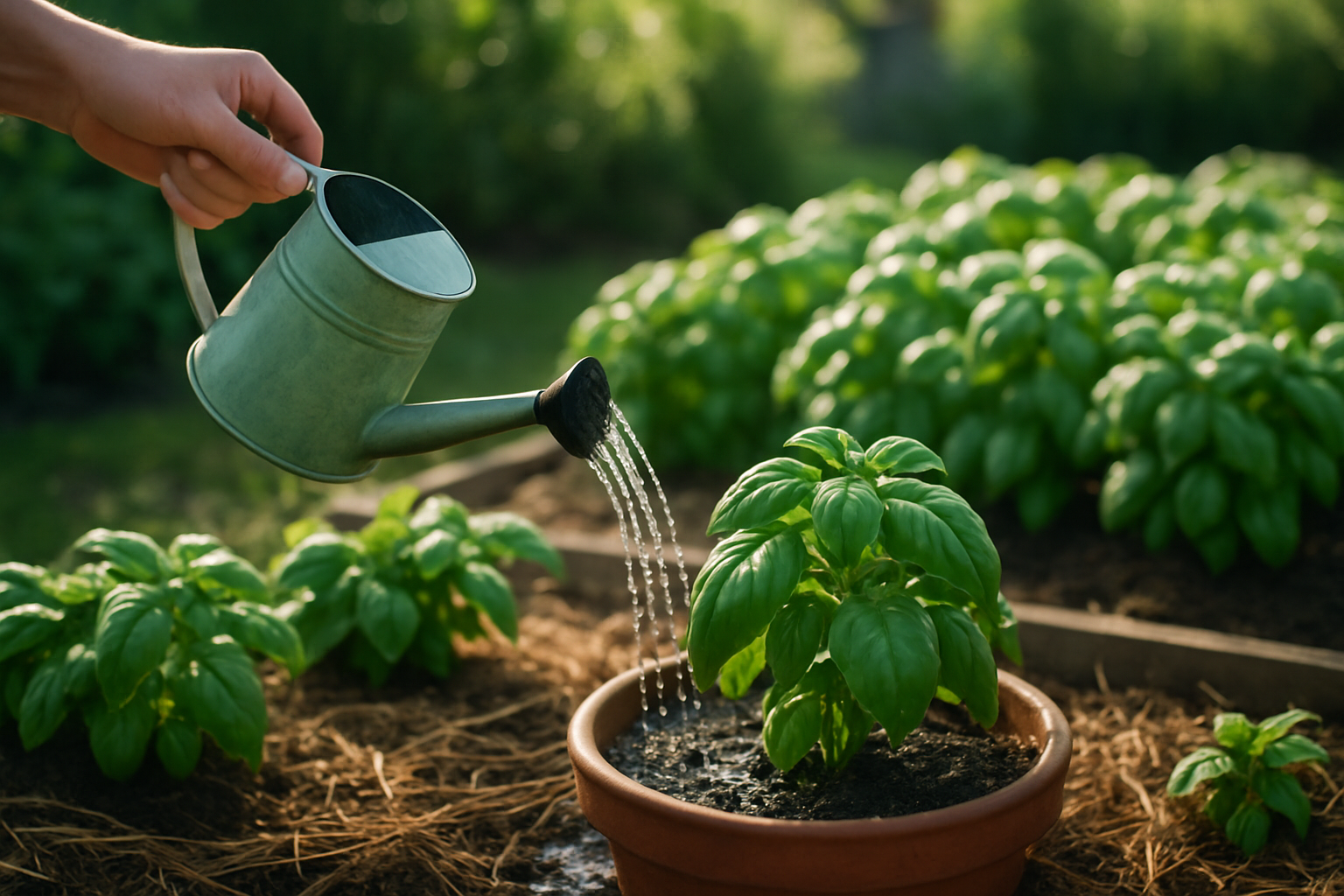
Maximizing your basil harvest starts with smart watering habits. Basil prefers deep, infrequent watering—aim to soak the soil thoroughly and then let the top inch dry out before your next session. This encourages roots to dig deep, making plants healthier and more drought-tolerant.
Avoid the temptation to sprinkle your basil every day; shallow watering only encourages weak roots and soggy, fungus-prone soil. To check when it’s time to water, stick your finger into the soil—if it feels dry an inch below the surface, it’s time to water.
Mulch around the base of your basil with straw or shredded leaves to lock in moisture, reduce weeds, and keep roots cool during hot spells. If you often forget to water, consider self-watering pots; these regulate moisture, protecting basil from both neglect and overwatering.
Always use quality, well-draining potting mix or amend your garden soil with compost to prevent root rot—basil hates soggy feet! If you’re using pots, choose ones with drainage holes and raise them slightly off the ground for better airflow.
By focusing on deep watering, good soil, and proper drainage, you’ll set your basil up for bountiful, fragrant harvests all season long.
Conclusion
Watering basil isn’t a one-size-fits-all task—success comes from paying attention to your plant’s unique needs. Remember to water when the top inch of soil feels dry, keep the leaves dry to prevent disease, and adjust your routine for changing weather or indoor conditions.
Whether your basil lives on a sunny kitchen windowsill or outside in a garden bed, staying observant will help ensure lush, fragrant growth.
How do you handle watering challenges with your basil? Have you found any tricks that work especially well? Share your experiences or questions in the comments below—we’d love to hear your stories!
